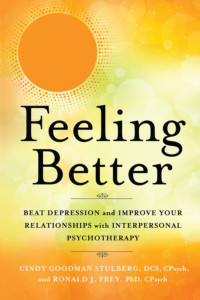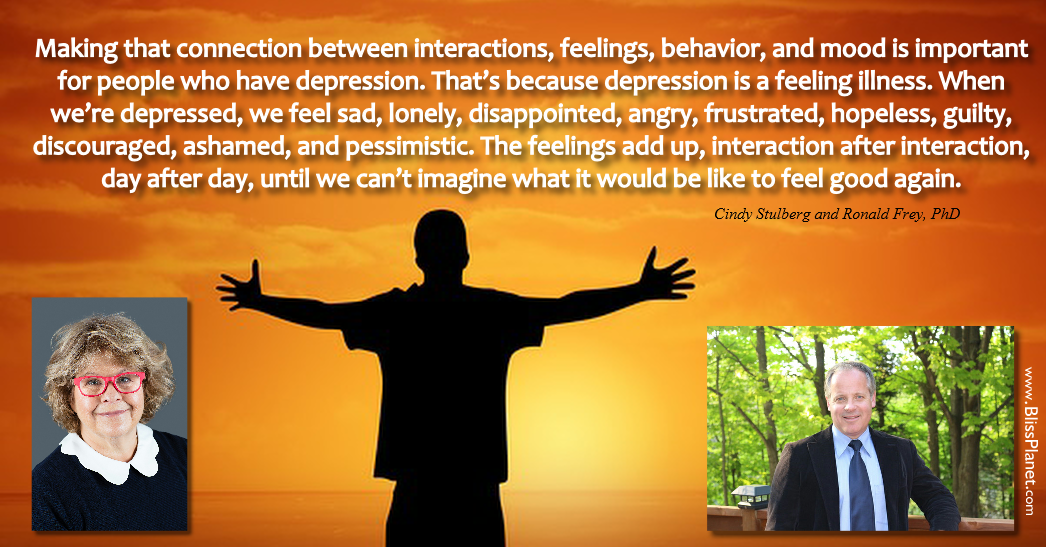An excerpt from Feeling Better by Cindy Stulberg and Ronald Frey, PhD
For years, the first line of defense for depression has been pharmaceuticals, but in their new book Feeling Better: Beat Depression and Improve Your Relationships with Interpersonal Psychotherapy (New World Library, November 20, 2018), psychologists and authors Cindy Goodman Stulberg and Ronald J. Frey, PhD, say that it is actually our relationships that offer the most effective path to healing.
Knowing that depression is an illness as legitimate as any physical ailment, Feeling Better helps readers get clarity around the four main areas in life that can be contributing factors to why people feel sad, blue, down, and depressed: life transitions, complicated grief, interpersonal conflict, or social isolation. We hope you’ll enjoy this excerpt from the book.
# # #
Let’s say you get home from work, and there are exactly eight pairs of your kids’ shoes cluttering up the hallway. Do you yell? Hide in your room feeling ashamed at your failure to instill personal responsibility in your children? Sigh, put the shoes away, and try to forget about it? Whichever reaction you have, how do you feel?
Imagine that you get a group text from a friend about a party everyone went to last night that you weren’t invited to. Do you text back something catty? Cry? Vent to someone? Depending on your response, how do you feel?
Your coworker invites you out for lunch and out of the blue tells you he doesn’t like the way you act in staff meetings. Do you listen quietly? Angrily defend your behavior? Say nothing and feel nauseous? Tell your spouse about it later? Whichever you do, how does it feel?
Your spouse calls to tell you that, for the third time this week, she can’t take the kids to soccer, because she has to stay late at work. Do you get mad and end the call quickly? Laugh and tell her she owes you dinner out this weekend? Tell her it’s okay, but inside you’re seething? How does your response make you feel?
There are no right or wrong answers to these questions. The point of our scenarios is simply to show that many of our feelings (and our resulting behavior) have an interpersonal component — they’re a direct result of the interactions we have with people every day. These interactions, either immediately or over time, affect our mood.
Making that connection between interactions, feelings, behavior, and mood is important for people who have depression. That’s because depression is a feeling illness. When we’re depressed, we feel sad, lonely, disappointed, angry, frustrated, hopeless, guilty, discouraged, ashamed, and pessimistic. The feelings add up, interaction after interaction, day after day, until we can’t imagine what it would be like to feel good again.
Feelings and Moods: What’s the Difference?
Feelings are the emotional reactions we have to experiences. When you put a number of similar feelings together, you have a mood.
A fight with your sister will trigger a feeling (or a few). That fight, plus the fact that you dropped your iPhone in the toilet, canceled a coffee date with a friend because you weren’t feeling up to it, skipped lunch, and ate a tub of ice cream, plus the fact that it’s raining for the fourth day in a row — all lead to a low mood. That mood might last for a couple of hours, lifting when your friend calls to check in, your kids come home from a sleepover, or the sun comes out. But it might continue into the next day if, for example, you don’t sleep well that night, stay inside the next day, and let the conflict with your sister simmer.
The Six F-words
The first step to managing our feelings is being able to name them — in the moment. It can be tough. When you see your mother-in-law’s number pop up on your phone, you aren’t asking, “How am I feeling?” You’re probably debating whether to answer the call. When your boss calls you into her office, you skip right past “How am I feeling?” You’re too busy grabbing last month’s sales reports and figuring out how to explain the results. When you’ve just told your friend something personal, you don’t ask, “How am I feeling?” Instead, you’re probably running through the conversation in your head again. “Did I say too much? Does he think I’m weird?”
It’s time to stop, take a breath, and ask yourself: How am I feeling? That’s because when you can name your feelings while you’re in the heat of battle or the throes of despair or anticipating a conversation with your mother-in-law, you’ll make better choices about how — and even whether — to act on them.
There may be dozens of emoticons on your phone, but there are only six main feelings — what we affectionately call the six F-words — sadness, fear, anger, surprise, happiness, and disgust.
These six emotions are hardwired into humans. Fear, for example, prompts the adrenaline-fueled “fight or flight” response. Disgust probably evolved to keep us safe from rotten food and contagious diseases. Anger helps protect us from threats.
Each of the six feelings triggers behavior. Four of them — disgust, fear, sadness, and surprise — cause us to back away from the situation (and the people) that prompted the feeling. Anger and happiness, in contrast, prompt us to engage with people. Anger, when expressed outwardly, usually leads to confrontation. Happiness makes us want to stick around and keep the feeling alive.
# # #
Cindy Goodman Stulberg, DCS, CPsych, and Ronald J. Frey, PhD, CPsych, are the authors of Feeling Better and directors of the Institute for Interpersonal Psychotherapy. Visit them online at http://interpersonalpsychotherapy.com.
Excerpted from the book Feeling Better. Copyright ©2018 by Cindy Goodman Stulberg and Ronald J. Frey. Printed with permission from New World Library — www.newworldlibrary.com.





